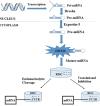MicroRNA and Cardiovascular Diseases
- PMID: 32018347
- PMCID: PMC7094181
- DOI: 10.4274/balkanmedj.galenos.2020.2020.1.94
MicroRNA and Cardiovascular Diseases
Abstract
Cardiovascular diseases are one of the most common causes of death in both developing and developed countries worldwide. Even though there have been improvements in primary prevention, the prevalence of cardiovascular diseases continues to increase in recent years. Hence, it is crucial to both investigate the molecular pathophysiology of cardiovascular diseases in-depth and find novel biomarkers regarding the early and proper prevention and diagnosis of these diseases. MicroRNAs, or miRNAs, are endogenous, conserved, single-stranded non-coding RNAs of 21-25 nucleotides in length. miRNAs have important roles in various cellular events such as embryogenesis, proliferation, vasculogenesis, apoptosis, cell growth, differentiation, and tumorigenesis. They also have potential roles in the cardiovascular system, including angiogenesis, cardiac cell contractility, control of lipid metabolism, plaque formation, the arrangement of cardiac rhythm, and cardiac cell growth. Circulating miRNAs are promising novel biomarkers for purposes of the diagnosis and prognosis of cardiovascular diseases. Cell or tissue specificity, stability in serum or plasma, resistance to degradative factors such as freeze-thaw cycles or enzymes in the blood, and fast-release kinetics, provide the potential for miRNAs to be surrogate markers for the early and accurate diagnosis of disease and for predicting middle- or long-term prognosis. Moreover, it may be a logical approach to combine miRNAs with traditional biomarkers to improve risk stratification and long-term prognosis. In addition to their efficacy in both diagnosis and prognosis, miRNA-based therapeutics may be beneficial for treating cardiovascular diseases using novel platforms and computational tools and in combination with traditional methods of analysis. microRNAs are promising, novel therapeutic agents, which can affect multiple genes using different signaling pathways. miRNAs therapeutic modulation techniques have been used in the settings of atherosclerosis, acute myocardial infarction, restenosis, vascular remodeling, arrhythmias, hypertrophy and fibrosis, angiogenesis and cardiogenesis, aortic aneurysm, pulmonary hypertension, and ischemic injury. This review presents detailed information about miRNAs regarding structure and biogenesis, stages of synthesis and functions, expression profiles in serum/plasma of living organisms, diagnostic and prognostic potential as novel biomarkers, and therapeutic applications in various diseases.
Keywords: Cardiovascular disease; gene expression; microRNAs.
Conflict of interest statement
Figures
References
-
- Carninci P, Kasukawa T, Katayama S, Gough J, Frith MC, Maeda N, et al. The transcriptional landscape of the mammalian genome. Science. 2005;309:1559–63. - PubMed
-
- Lee RC, Feinbaum RL, Ambros V. The C. elegans heterochronic gene lin-4 encodes small RNAs with antisense complementarity to lin-14. Cell. 1993;75:843–54. - PubMed
MeSH terms
Substances
LinkOut - more resources
Full Text Sources

